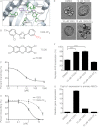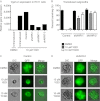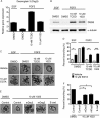Chemical genetic screen reveals a role for desmosomal adhesion in mammary branching morphogenesis
- PMID: 23212921
- PMCID: PMC3554898
- DOI: 10.1074/jbc.M112.411033
Chemical genetic screen reveals a role for desmosomal adhesion in mammary branching morphogenesis
Abstract
During the process of branching morphogenesis, the mammary gland undergoes distinct phases of remodeling to form an elaborate ductal network that ultimately produces and delivers milk to newborn animals. These developmental events rely on tight regulation of critical cellular pathways, many of which are probably disrupted during initiation and progression of breast cancer. Transgenic mouse and in vitro organoid models previously identified growth factor signaling as a key regulator of mammary branching, but the functional downstream targets of these pathways remain unclear. Here, we used purified primary mammary epithelial cells stimulated with fibroblast growth factor-2 (FGF2) to model mammary branching morphogenesis in vitro. We employed a forward chemical genetic approach to identify modulators of this process and describe a potent compound, 1023, that blocks FGF2-induced branching. In primary mammary epithelial cells, we used lentivirus-mediated knockdown of the aryl hydrocarbon receptor (AHR) to demonstrate that 1023 acts through AHR to block branching. Using 1023 as a tool, we identified desmosomal adhesion as a novel target of AHR signaling and show that desmosomes are critical for AHR agonists to block branching. Our findings support a functional role for desmosomes during mammary morphogenesis and also in blocking FGF-induced invasion.
Figures





Similar articles
-
Linked expression of Ah receptor, ARNT, CYP1A1, and CYP1B1 in rat mammary epithelia, in vitro, is each substantially elevated by specific extracellular matrix interactions that precede branching morphogenesis.Toxicol Sci. 2004 Nov;82(1):46-61. doi: 10.1093/toxsci/kfh242. Epub 2004 Aug 5. Toxicol Sci. 2004. PMID: 15297627
-
The receptor protein tyrosine phosphatase PTPRB negatively regulates FGF2-dependent branching morphogenesis.Development. 2017 Oct 15;144(20):3777-3788. doi: 10.1242/dev.149120. Epub 2017 Sep 4. Development. 2017. PMID: 28870991 Free PMC article.
-
FGF ligands of the postnatal mammary stroma regulate distinct aspects of epithelial morphogenesis.Development. 2014 Sep;141(17):3352-62. doi: 10.1242/dev.106732. Epub 2014 Jul 30. Development. 2014. PMID: 25078648 Free PMC article.
-
Cripto: a novel epidermal growth factor (EGF)-related peptide in mammary gland development and neoplasia.Bioessays. 1999 Jan;21(1):61-70. doi: 10.1002/(SICI)1521-1878(199901)21:1<61::AID-BIES8>3.0.CO;2-H. Bioessays. 1999. PMID: 10070255 Review.
-
Roles of hepatocyte growth factor/scatter factor and transforming growth factor-beta1 in mammary gland ductal morphogenesis.J Mammary Gland Biol Neoplasia. 1998 Apr;3(2):133-50. doi: 10.1023/a:1018790705727. J Mammary Gland Biol Neoplasia. 1998. PMID: 10819523 Review.
Cited by
-
Heterotypic control of basement membrane dynamics during branching morphogenesis.Dev Biol. 2015 May 1;401(1):103-9. doi: 10.1016/j.ydbio.2014.12.011. Epub 2014 Dec 16. Dev Biol. 2015. PMID: 25527075 Free PMC article. Review.
-
The Terminal End Bud: the Little Engine that Could.J Mammary Gland Biol Neoplasia. 2017 Jun;22(2):93-108. doi: 10.1007/s10911-017-9372-0. Epub 2017 Feb 6. J Mammary Gland Biol Neoplasia. 2017. PMID: 28168376 Free PMC article. Review.
-
Bis-aryloxadiazoles as effective activators of the aryl hydrocarbon receptor.Bioorg Med Chem Lett. 2014 Jun 1;24(11):2473-6. doi: 10.1016/j.bmcl.2014.04.013. Epub 2014 Apr 13. Bioorg Med Chem Lett. 2014. PMID: 24767852 Free PMC article.
-
Dioxin exposure blocks lactation through a direct effect on mammary epithelial cells mediated by the aryl hydrocarbon receptor repressor.Toxicol Sci. 2015 Jan;143(1):36-45. doi: 10.1093/toxsci/kfu203. Epub 2014 Sep 29. Toxicol Sci. 2015. PMID: 25265996 Free PMC article.
-
Differentiation of mammary tumors and reduction in metastasis upon Malat1 lncRNA loss.Genes Dev. 2016 Jan 1;30(1):34-51. doi: 10.1101/gad.270959.115. Epub 2015 Dec 23. Genes Dev. 2016. PMID: 26701265 Free PMC article.
References
Publication types
MeSH terms
Substances
Grants and funding
LinkOut - more resources
Full Text Sources
Other Literature Sources
Molecular Biology Databases

